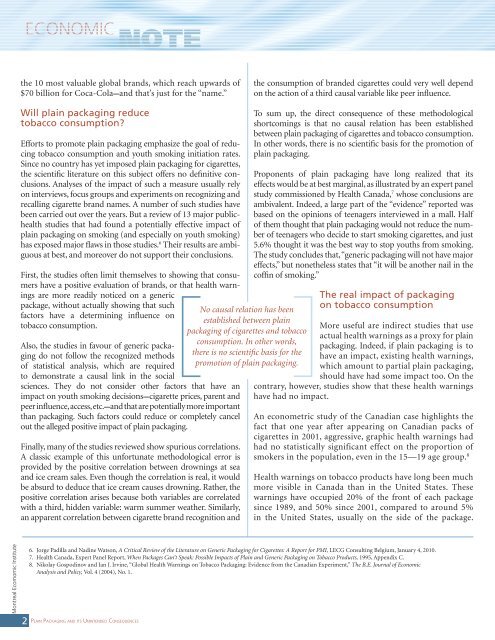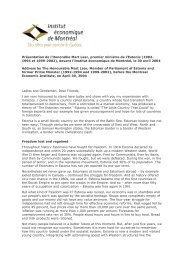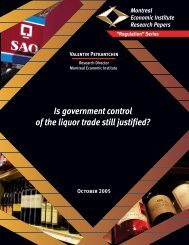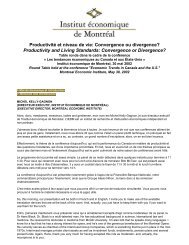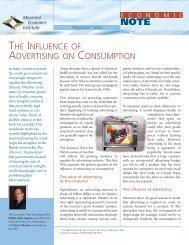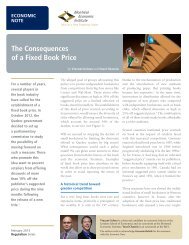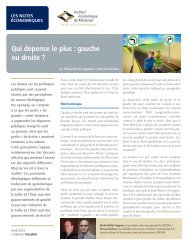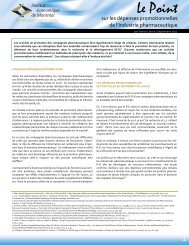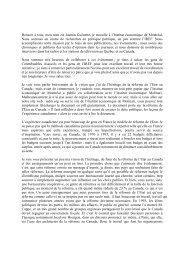Plain Packaging and its Unintended Consequences - IEDM
Plain Packaging and its Unintended Consequences - IEDM
Plain Packaging and its Unintended Consequences - IEDM
You also want an ePaper? Increase the reach of your titles
YUMPU automatically turns print PDFs into web optimized ePapers that Google loves.
Montreal Ecomomic Institute<br />
2<br />
ECONOMIC NOTE<br />
the 10 most valuable global br<strong>and</strong>s, which reach upwards of<br />
$70 billion for CocaCola—<strong>and</strong> that’s just for the “name.”<br />
Will plain packaging reduce<br />
tobacco consumption?<br />
Efforts to promote plain packaging emphasize the goal of reducing<br />
tobacco consumption <strong>and</strong> youth smoking initiation rates.<br />
Since no country has yet imposed plain packaging for cigarettes,<br />
the scientific literature on this subject offers no definitive conclusions.<br />
Analyses of the impact of such a measure usually rely<br />
on interviews, focus groups <strong>and</strong> experiments on recognizing <strong>and</strong><br />
recalling cigarette br<strong>and</strong> names. A number of such studies have<br />
been carried out over the years. But a review of 13 major publichealth<br />
studies that had found a potentially effective impact of<br />
plain packaging on smoking (<strong>and</strong> especially on youth smoking)<br />
has exposed major flaws in those studies. 6 Their results are ambiguous<br />
at best, <strong>and</strong> moreover do not support their conclusions.<br />
First, the studies often limit themselves to showing that consumers<br />
have a positive evaluation of br<strong>and</strong>s, or that health warnings<br />
are more readily noticed on a generic<br />
package, without actually showing that such<br />
factors have a determining influence on<br />
tobacco consumption.<br />
Also, the studies in favour of generic packaging<br />
do not follow the recognized methods<br />
of statistical analysis, which are required<br />
to demonstrate a causal link in the social<br />
sciences. They do not consider other factors that have an<br />
impact on youth smoking decisions—cigarette prices, parent <strong>and</strong><br />
peerinfluence,access,etc.—<strong>and</strong>thatarepotentiallymoreimportant<br />
than packaging. Such factors could reduce or completely cancel<br />
out the alleged positive impact of plain packaging.<br />
Finally, many of the studies reviewed show spurious correlations.<br />
A classic example of this unfortunate methodological error is<br />
provided by the positive correlation between drownings at sea<br />
<strong>and</strong> ice cream sales. Even though the correlation is real, it would<br />
be absurd to deduce that ice cream causes drowning. Rather, the<br />
positive correlation arises because both variables are correlated<br />
with a third, hidden variable: warm summer weather. Similarly,<br />
an apparent correlation between cigarette br<strong>and</strong> recognition <strong>and</strong><br />
the consumption of br<strong>and</strong>ed cigarettes could very well depend<br />
on the action of a third causal variable like peer influence.<br />
To sum up, the direct consequence of these methodological<br />
shortcomings is that no causal relation has been established<br />
between plain packaging of cigarettes <strong>and</strong> tobacco consumption.<br />
In other words, there is no scientific basis for the promotion of<br />
plain packaging.<br />
Proponents of plain packaging have long realized that <strong>its</strong><br />
effects would be at best marginal, as illustrated by an expert panel<br />
study commissioned by Health Canada, 7 whose conclusions are<br />
ambivalent. Indeed, a large part of the “evidence” reported was<br />
based on the opinions of teenagers interviewed in a mall. Half<br />
of them thought that plain packaging would not reduce the number<br />
of teenagers who decide to start smoking cigarettes, <strong>and</strong> just<br />
5.6% thought it was the best way to stop youths from smoking.<br />
The study concludes that,“generic packaging will not have major<br />
effects,” but nonetheless states that “it will be another nail in the<br />
coffin of smoking.”<br />
The real impact of packaging<br />
on tobacco consumption<br />
More useful are indirect studies that use<br />
actual health warnings as a proxy for plain<br />
packaging. Indeed, if plain packaging is to<br />
have an impact, existing health warnings,<br />
which amount to partial plain packaging,<br />
should have had some impact too. On the<br />
contrary, however, studies show that these health warnings<br />
have had no impact.<br />
An econometric study of the Canadian case highlights the<br />
fact that one year after appearing on Canadian packs of<br />
cigarettes in 2001, aggressive, graphic health warnings had<br />
had no statistically significant effect on the proportion of<br />
smokers in the population, even in the 15—19 age group. 8<br />
Health warnings on tobacco products have long been much<br />
more visible in Canada than in the United States. These<br />
warnings have occupied 20% of the front of each package<br />
since 1989, <strong>and</strong> 50% since 2001, compared to around 5%<br />
in the United States, usually on the side of the package.<br />
6. Jorge Padilla <strong>and</strong> Nadine Watson, A Critical Review of the Literature on Generic <strong>Packaging</strong> for Cigarettes: A Report for PMI, LECG Consulting Belgium, January 4, 2010.<br />
7. Health Canada, Expert Panel Report, When Packages Can’t Speak: Possible Impacts of <strong>Plain</strong> <strong>and</strong> Generic <strong>Packaging</strong> on Tobacco Products, 1995, Appendix C.<br />
8. Nikolay Gospodinov <strong>and</strong> Ian J. Irvine, “Global Health Warnings on Tobacco <strong>Packaging</strong>: Evidence from the Canadian Experiment,” The B.E. Journal of Economic<br />
Analysis <strong>and</strong> Policy, Vol. 4 (2004), No. 1.<br />
<strong>Plain</strong> <strong>Packaging</strong> <strong>and</strong> <strong>its</strong> <strong>Unintended</strong> conseqUences<br />
No causal relation has been<br />
established between plain<br />
packaging of cigarettes <strong>and</strong> tobacco<br />
consumption. In other words,<br />
there is no scientific basis for the<br />
promotion of plain packaging.


